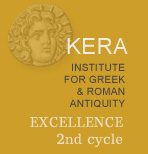Main Site . Sebasteion
10. Dedication of a statue of Nerva
![]()
| Αὐτοκράτορα Νέρου– αν Καίσαρα Σεβαστὸν Βουβωνέων ἡ βουλὴ καὶ ὁ δῆμος. |
The council and the people of Boubon (dedicated this statue of) the Emperor Nerva Caesar Augustus.
Inscription on the pedestal at the north wall of the Sebasteion. The inscription occupies the upper half of blocks E 4 and 5.
Letters: 3-5.5 cm.
Jones 1979, no. 6 (pl. 76.2); SEG 27 (1977), no. 918; İnan 1993 (pl. XIII, E cf. XV and XVI.12)
Jones, rightly, draws attention to the asymmetrical disposition of the text and the two forms of sigma in this inscription, and points to an erased inscription under this one, which may have extended to block E 6, as there are traces of erasure there too (Jones, op. cit., 291-292). Such traces are clearly discernible to the left of l. 3 (a delta) and to the right of l. 2 (an omicron). Less clearly, but still recognizable, there are traces to the left of line 1 and slightly higher: ΚΛΙ; further, slightly above l. 1: the curve of a rho or beta, then, after a lacuna of ca. 3 letters: ONI, then E; to the left of line 2 and slightly higher: A ı I; between ll. 1 and 2: OıAΓΙ_ΚΑ; to the right of l. 2 after the omicron on stone E 6: Σ; between ll. 2 and 3 and to their left: ΒΟ; to the right of l. 3 on stone E 6: E_E; to the left of l. 4, after the delta, a vertical stroke; beneath l. 4: Λ. Τ C Δ; to the right of l. 5 on stone E 6: O. The remains of erased letters to the right of l. 2 on stone E 6 (ΟΣ) are on a different level than those still visible to the left of the preserved text for Nerva. It seems likely, then, that there had been more than one erasure on stones E 4-6, and that the erased inscription on stone E 6 was a different one from that traceable to the left of the dedication for Nerva. Unfortunately, someone has tried to "highlight" the erased letters by tracing them with a sharp instrument, thus causing even more confusion. Jones and İnan suggest that an earlier text may have honored Domitian (Jones, op. cit., p. 292, İnan, op. cit., pp. 219-220). Nerva's predecessor is of course a good candidate, since his portraits were subjected to damnatio memoriae. On the other hand, one of the earlier Antonines may also have been given a statue here originally, which was re-located in the course of the numerous adjustments made on the sculptural program of this room. It is also possible that Trajan, Hadrian, Antoninus Pius and their wives were removed from this room to be placed as a separate group in a different room of the building; see the general discussion of the Sebasteion and cf. Price 1984, p. 264 on a head of Antoninus Pius which may have come from this building. Be that as it may, the dedication of the statue of Nerva, as it is preserved today, must be an (unsuccessful) third century imitation of the original inscription.

